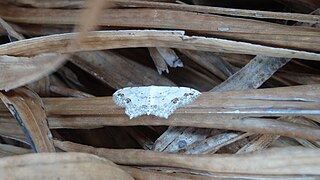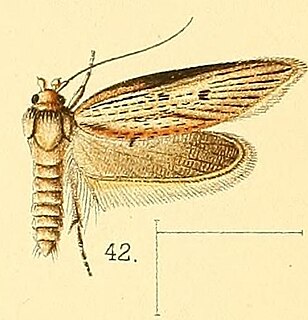Ochmastis is a genus of moth in the family Gelechiidae. It contains the species Ochmastis chionacma, which is found in southern Burma.

Scopula pulchellata is a moth of the family Geometridae. It is found in the Indo-Australian tropics, from India, Sri Lanka to Taiwan and the Solomon Islands, as well as in Africa.

Procometis acutipennis is a moth of the family Autostichidae. It is known from the Gambia and Congo.
Procometis trochala is a moth of the family Autostichidae. It is found in Sri Lanka and India (Bengal).
Procometis diplocentra is a moth of the family Autostichidae that is found in Queensland, the Australian Capital Territory, New South Wales and Victoria.
Procometis bisulcata is a moth in the family Autostichidae. It was described by Edward Meyrick in 1890. It is found in Australia, where it has been recorded from New South Wales.
Procometis genialis is a moth in the family Autostichidae. It was described by Edward Meyrick in 1890. It is found in Australia, where it has been recorded from Queensland.
Procometis hylonoma is a moth in the family Autostichidae. It was described by Edward Meyrick in 1890. It is found in Australia, where it has been recorded from New South Wales, Victoria, and South Australia.
Procometis lipara is a moth in the family Autostichidae. It was described by Edward Meyrick in 1890. It is found in Australia, where it has been recorded from New South Wales.
Procometis monocalama is a moth in the family Autostichidae. It was described by Edward Meyrick in 1890. It is found in Australia, where it has been recorded from New South Wales.
Procometis limitata is a moth in the family Autostichidae. It was described by Edward Meyrick in 1911. It is found in South Africa.
Procometis mistharma is a moth in the family Autostichidae. It was described by Edward Meyrick in 1908. It is found in Sri Lanka.
Procometis sphendonistis is a moth in the family Autostichidae. It was described by Edward Meyrick in 1908. It is found in Sri Lanka.
Procometis spoliatrix is a moth in the family Autostichidae. It was described by Edward Meyrick in 1916. It is found in southern India.
Procometis brunnea is a moth in the family Autostichidae. It was described by West in 1931. It is found in Taiwan.
Procometis melanthes is a moth in the family Autostichidae. It was described by Turner in 1898. It is found in Australia, where it has been recorded from Queensland.
Procometis periscia is a moth in the family Autostichidae. It was described by Oswald Bertram Lower in 1903. It is found in Australia, where it has been recorded from Victoria.
Chlamydastis ommatopa is a moth of the family Depressariidae. It is found in Colombia and Bolivia.
Lecithocera decorosa is a moth in the family Lecithoceridae. It was described by Alexey Diakonoff in 1968. It is found on Luzon in the Philippines.
Chlamydastis mochlopa is a moth in the family Depressariidae. It was described by Edward Meyrick in 1915. It is found in Guyana.

